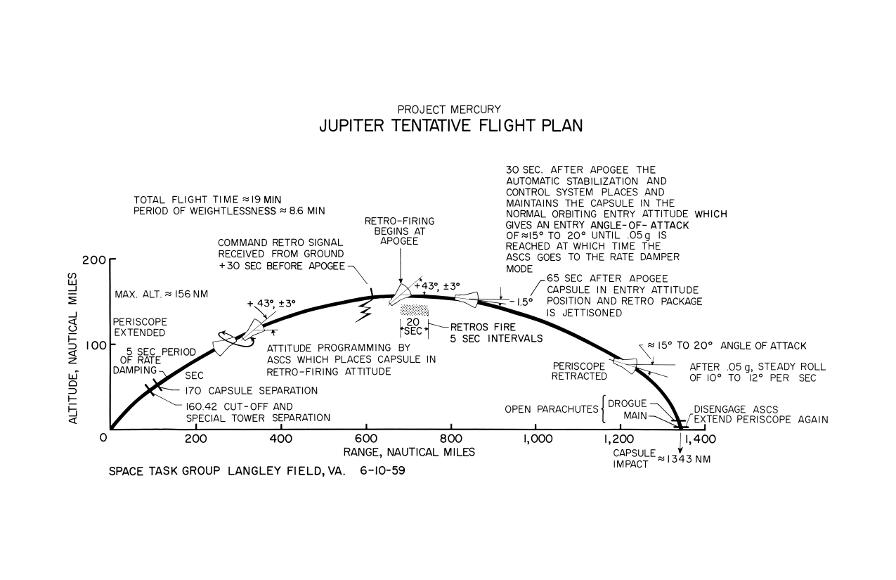Project Mercury Jupiter Flight Plan
While most people are familiar with the use of Project Mercury's use of Redstone and Atlas boosters, and a few people are even familiar with the use of Little Joe boosters, even fewer are aware of the proposed use of Jupiter missiles to launch Mercury spacecraft.
Here's a Space Task Group diagram, dated June 10 1959, containing the tentative Mercury-Jupiter flight plan.
Click image for a 1669x1080 pixel version of this image in a new window, or
click here for a
10200x6600
pixel version of this image in a new window.
Located in the Jacobi Collection, Dept. of Archives/Special
Collections,
M. Louis Salmon Library, University of Alabama in Huntsville.
Scan and assembly by heroicrelics.
The Jupiter flights would have a maximum altitude of 156 nautical miles (compared to 108 nm in the Project Mercury Redstone flight plan) and had a range of 1,343 nm (versus only 177 nm for the Redstone flights).
Major phases of the Mercury-Jupiter flight profile noted on the diagram include
- Cut-off and special tower separation (heroicrelics is not certain what makes this "special")
- Capsule separation (from booster)
- Periscope extended
- Attitude programming by ASCS which places capsule in retro-firing attitude
- Command retro signal received from ground + 30 sec before apogee
- Retro-firing begins at apogee
- Retros fire, 5 sec intervals
- 10 seconds after retro-firing the automatic stabilization and control system places and maintains the capsule in an entry attitude of -30° which gives a 30° angle-of-attack when .05g is reached on entry into the effective atmosphere. After .05g the ASCS goes to the rate damper mode.
- 30 seconds after apogee capsule starts into entry attitude position
- 65 seconds after apogee capsule in entry attitude position and retro package is jettisoned
- Periscope retracted
- Open parachutes (drogue and main)
- Disengage ASCS
- Extend periscope again
During early Project Mercury planning, it was clear that the only booster with the thrust necessary to orbit a manned spacecraft was the Atlas, it was desirable to perform suborbital testing as well. A purpose-built Little Joe launch vehicle could be used to perform abort testing and the Redstone would be available for short-range testing, but there seemed to be a need for "intermediate qualification and training flights". The Army's Jupiter and the Air Force's Thor were under consideration for these intermediate flights.
Langley Research Center and Space Task Group personnel made several visits the Army Ballistic Missile Agency at the Redstone Arsenal in Huntsville, AL at the end of 1958, where they were convinced that the Jupiter was the best choice, and in January NASA placed an order for eight Redstone and two Jupiter launch vehicles in support of Project Mercury; in February, it was decided that the ABMA would also construct the adapters for the Mercury-Jupiter configuration.
By March 1959, the Mercury-Jupiter flight program had been planned: The first flight would be unmanned and the second would carry primate passenger. The Mercury-Jupiter program would then conclude. The Space Task Group was especially interested in obtaining reentry heating data. At 16,000 feet per second, a Jupiter could accelerate a spacecraft about midway between the capabilities of a Little Joe or Redstone (6,000 fps) and an Atlas (25,000 fps). Changes in accounting led to an increase in the cost of the Jupiter launches, putting them equal to or greater than the cost of Atlas launches. Because of the rising costs and because the same or better data could be obtained from Atlas flights, the the order for Jupiter launch vehicles in support of Project Mercury was cancelled on July 1, putting an end to the Jupiter phase of the program.
Although the Mercury-Jupiter program was short-lived (the initial ABMA visit was in October 1958 and it was cancelled in July 1959) and this is the only vintage material I've found which was related to it, the Mercury-Jupiter program seems to have caught the attention of some scale modellers on the Ninfinger Productions Website. Someone took a launch photo of Juno II AM-19A and replaced its upper stages with a Mercury spacecraft. Another contributor produced a CAD drawing comparing the Mercury-Redstone, Mercury-Jupiter, and Mercury-Atlas configurations. See this page and use your browser's "find" feature to search for the two links containing "Mercury_Jupiter" (with an underscore).

